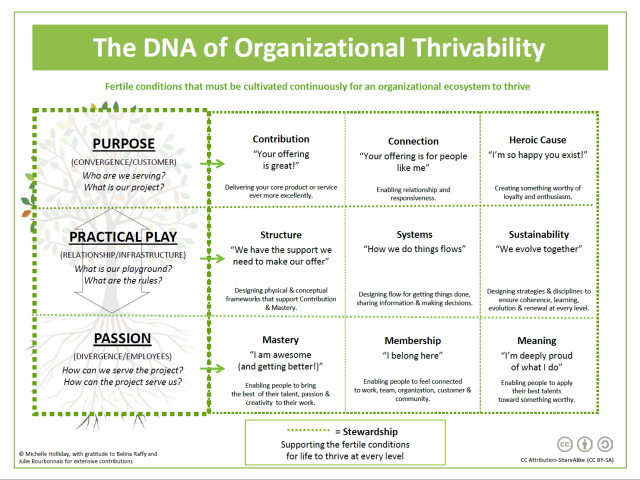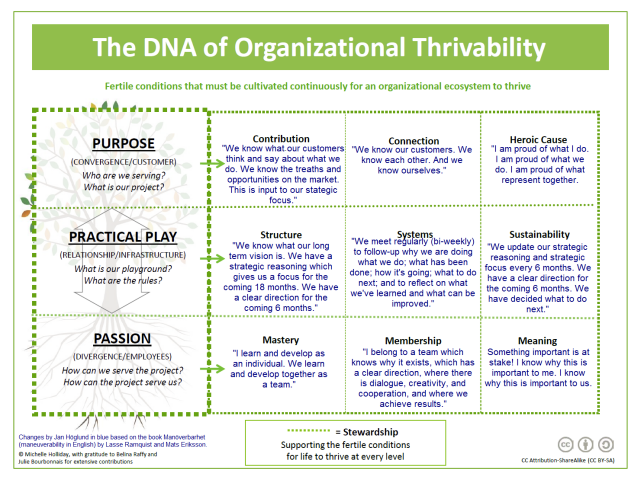This is a post in my series on organizing “between and beyond.” Other posts are here. The purpose of this post is to compare Michell Holliday’s framework for organizational thrivability with Integral Management, which I have written about here.
Background
Michelle Holliday is a facilitator, consultant, researcher, presenter, and writer. Her work centers around ”thrivability,” which is based on a view of organizations and communities as living systems. It’s this view which Michelle Holliday eloquently elaborates in her new book, The Age of Thrivability: Vital Perspectives and Practices for a Better World, which will be released this fall. Here is my book review.
Patterns
Michelle Holliday uses the metaphor of a tree to offer useful guidance to living systems patterns:1
- Divergent Parts (Individual People).2
- Patterns of Relationship (Connective Infrastructure).3
- Convergent Wholeness (Shared Identity & Purpose).4
- Self-integration (Divergence, relationship, and convergence are self-organizing).5
Framework
Michelle Holliday has, with extensive contributions from Belina Raffy and Julie Bourbonnais, developed a framework that is based on the tree metaphor. The framework goes into another level of detail, beyond the tree. See figure 1. For example, if the root system represents divergent parts – or people within the organization – then the “fertile conditions” that must be cultivated are Mastery, Membership and Meaning. Here is a webinar where Michelle gives an explanation of the framework.

Comparison
Michelle Holliday’s framework is an integral framework that is nicely aligned with Integral Management, which I have written about here. Integral Management also views the organization as a living system,6 and explicitly focuses on the team as a “living group”7 and the leadership which is needed to ensure that the conditions of life are put in place.8 Leadership is needed to inspire and focus the energy, to facilitate interplay and learning, and to ensure a steady outflow of results.9 The leadership is distributed within the team. I have mapped some of the components in Integral Management into Michelle’s framework. See figure 2. My changes are in blue, which are based on the book Manöverbarhet (maneuverability in English) by Lasse Ramquist and Mats Eriksson. My translation from Swedish to English.

Notes:
1 Michelle Holliday, The Age of Thrivability: Vital Perspectives and Practices for a Better World, p. 97.
2 Ibid., p. 29.
3 Ibid., p. 30.
4 Ibid..
5 Ibid., p. 31.
6 Lasse Ramquist & Mats Eriksson, Manöverbarhet: VU-processen—en ledningsmodell för strategisk fokusering, medarbetarengagemang och konkurrens på livets villkor (Ekerlids Förlag, 2000), pp. 158–164, 193–194.
7 Ibid., pp. 146–152, 165–194.
8 Ibid., pp. 230–265.
9 Lasse Ramquist & Mats Eriksson, Integral Management (Lasse Ramquist AB, 2nd ed. 2009), pp. 176–187.
Related posts:
Organizing in between and beyond posts
Leave a Reply
You must be logged in to post a comment.